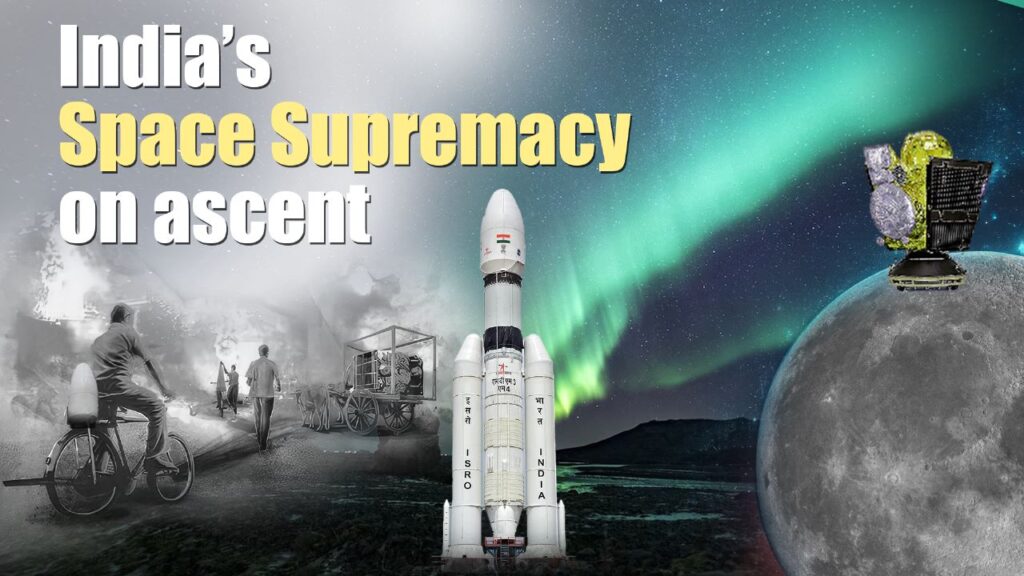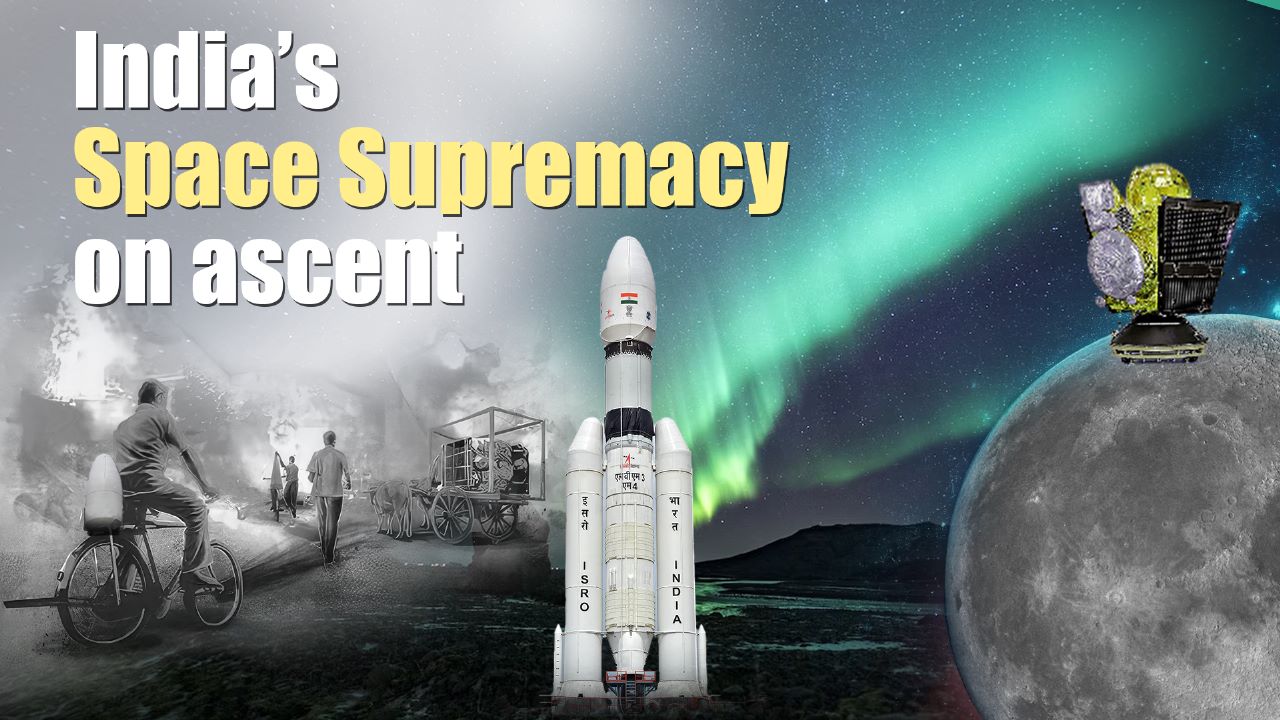
India\’s Space Supremacy on Ascent
Chandrayaan-3, ISRO\’s premier lunar exploration is a milestone in its path to achieving greater excellence, cost competitiveness and emerge as space power
Rahul Pawa
Human space exploration has predominantly been shaped by superpowers of the Cold War era, with US space agency, NASA and its Russian counterpart, Roscosmos leading the way. This is a thing of the past.

In recent decades, the biggest surprising candidate in contention is the Indian Space Research Organisation (ISRO). Though it started late and faces financial limitations as well as technological constraints, ISRO has demonstrated remarkable resilience and determination, carving out a unique path as a top-tier global space agency.
Established in 1969, almost two decades after NASA, ISRO embarked on its journey amidst a space race that was already in full swing. Tasked with the formidable mission of propelling India into the age of space technology and catching up with technologically advanced nations, ISRO\’s journey has been far from smooth.
In the aftermath of India\’s nuclear tests in 1974 and 1998, the nation faced broad international sanctions. This development dealt a significant blow to India\’s space aspirations when Russia, succumbing to pressure from the Western world, cited the Missile Technology Control Regime (MTCR) and withdrew from an agreement to transfer crucial cryogenic engine technology to India.
The cryogenic engine technology was indispensable for the development of heavy-lift launch vehicles. Such a setback could have easily derailed India\’s ambitions. Instead, it ignited ISRO\’s determination, fuelling its drive towards self-reliance and innovation.
Over next two decades, ISRO focused its efforts on developing its own cryogenic engine technology. Despite numerous challenges, India\’s space agency remained unwavering and in January 2014, it successfully launched the GSLV-D5 launch vehicle, powered by an indigenously developed cryogenic engine.
This achievement serves as an exemplary showcase of perseverance and resilience in the face of adversity, a testament to ISRO\’s unwavering commitment to its mission and the Indian Republic.
Yet, this is just one chapter in the compelling saga of ISRO, where hurdles are transformed into springboards for success. It is a testament to ISRO\’s prowess in transforming adversity into opportunity, illuminating India\’s flourishing technological capabilities. As ISRO navigated its journey, it pioneered a new paradigm in space exploration, combining cost-effectiveness with ambition, establishing itself as a trailblazer in affordable space technology.
The Mars Orbiter Mission, known as Mangalyaan, epitomises this innovative spirit. Accomplished at a fraction of the cost of similar missions by other agencies, Mangalyaan was not just a frugal exploration but a powerful demonstration of ISRO\’s formidable capabilities to the world. A vivid illustration of ISRO\’s economical yet ambitious spirit is its mastery of multi-launch capabilities, allowing multiple satellites to be taken into orbit with a single rocket. ISRO showcased this brilliantly in February 2017 when it successfully launched a record-breaking 104 satellites aboard a single PSLV-C37 rocket. This launch included not only India\’s own earth observation satellite but also miniature satellites from several international players, underscoring ISRO\’s leading role in the global commercial space industry.
Furthermore, ISRO\’s ability to maintain budgetary controls without compromising on scientific endeavours sets it apart from many international counterparts. Whether it is launching the world\’s lightest satellite or sending a mission to Mars at a cost lower than a Hollywood blockbuster, ISRO\’s exemplary record reflects that cost-effectiveness and ambitious exploration can indeed go hand in hand.
Chandrayaan-3, the latest iteration of ISRO\’s flagship lunar exploration mission, is poised to embark on its momentous journey, aiming to achieve a soft landing in the Moon\’s South Polar region on August 23, 2023 at 5:47 pm. This extraordinary endeavour, born out of years of rigorous scientific inquiry, stands as evidence of India\’s expanding influence as a formidable force in space exploration.
Chandrayaan-3 aims to succeed where its predecessor fell short, achieving a precise and controlled landing on the lunar surface. The proposition for an Indian moon mission was formally announced by former Indian Prime Minister Atal Bihari Vajpayee during his 2003 Independence Day address, and in 2008, Chandrayaan-1 was launched, marking a significant milestone in India\’s cosmic journey.
Comprising a lunar orbiter and impactor, Chandrayaan-1 not only fulfilled its scientific ambitions but also propelled India into an elite group of lunar explorers. Even before Chandrayaan-1 landed, ISRO and Roscosmos planned its sequel, Chandrayaan-2, with the goal of a moon landing and rover exploration. Due to delays from Roscosmos, ISRO independently developed a lander, pushing the launch to 2019.
Technical setbacks and rescheduling notwithstanding, Chandrayaan-2 finally took off on July 22, 2019. Tragically, a software glitch on September 6, 2019, caused the Chandrayaan-2 lander to malfunction, resulting in the loss of communication with ISRO and loss of both the lander and the rover. This incident led to the development of Chandrayaan-3, the next phase of the mission, with the ambitious aim of achieving a successful soft lunar landing.
With the clock ticking down, ISRO is diligently overseeing the timeline for the lunar touchdown, taking into account elements such as lunar sunrise. In case circumstances demanded, the landing can be pushed to September from the scheduled August 23 this year. Every step forward brings India\’s Chandrayaan-3 closer to a ground breaking achievement on the moon. Successfully achieving this would place India in an elite group of nations; to date, only the US, Russia, and China have accomplished this feat.
Odyssey of ISRO embodies the indomitable spirit of human endeavour—an unwavering resolve, tireless perseverance, and self-reliance that magnify India\’s ascent as an increasingly formidable space superpower, bolstering its commanding presence within the global space community. Having begun as a latecomer, ISRO has transcended the confines of limitations and boldly challenged established order, thereby demonstrating that constraints are merely catalysts for boundless opportunities.
ISRO\’s unwavering dedication to perpetual learning, adaptability, and evolution has empowered it to overcome formidable obstacles and lay a robust groundwork for future triumphs. Through a multitude of accomplishments, it has forged an upward trajectory for India, shaping it into a rising space superpower of exceptional versatility.
(Author is Research Director at Centre for Integrated and Holistic Studies, a non-partisan think tank based in New Delhi)

